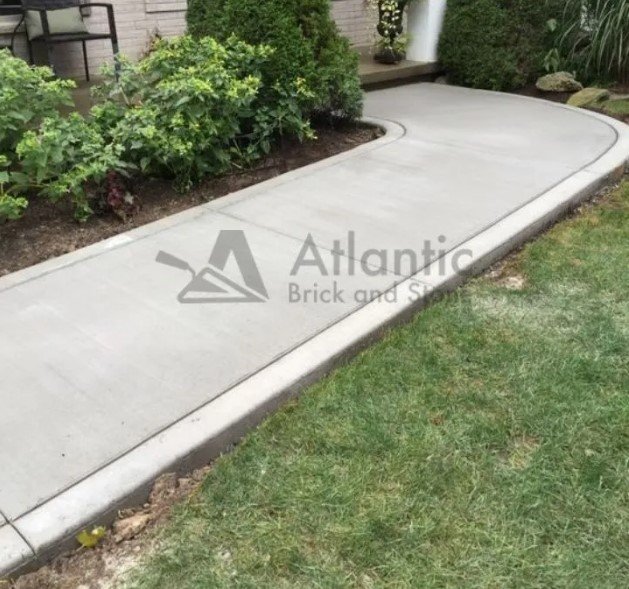When you have a concrete sidewalk around your home, you likely expect it to withstand daily foot traffic and environmental conditions. However, over time concrete sidewalks can develop cracks that need to be addressed. In this guide, we’ll walk through how to properly identify, assess and repair cracks in your concrete walkway.

Concrete sidewalks are a common surface for walkways because concrete is a durable material when properly installed and maintained. A standard residential sidewalk is usually four to six inches thick and constructed of a mixture of cement, sand, and gravel or crushed stone called aggregate. This mix forms a hardened surface that can support weight while being weather resistant.
There are a few key reasons why cracks may develop in concrete walkways, even when installed properly:
Properly identifying the specific crack is important for determining the best repair approach. Here are some common crack types to watch for in concrete sidewalks:
There are a few main types of cracks to be aware of:
Once you have identified all cracks present, the next important step is to gauge the severity of each one to determine an appropriate repair approach. Here are some factors to consider when evaluating crack severity:
The severity of the cracks will determine whether repair or replacement of the sidewalk is necessary. Hairline cracks less than 1/8 inch deep can usually be cleaned and filled with concrete crack filler. Small shallow cracks between 1/8 to 1/4 inch may only require repair of isolated issues, while multiple or intersecting cracks in this range could mean replacement is better. Cracks wider than 1/4 inch will likely require replacing the entire section since repairs won’t be very durable. Sections with significant deterioration, crumbling, or structural issues also need replacement as do areas with extensive networked cracking patterns or major lifting and shifting of the surface.
For larger or complex sidewalk crack repairs, it’s often best to hire a professional contractor. Specialized tools and equipment or situations that require adherence to building codes justify bringing in experts. Professionals are needed if there are extensive cracks over large areas like more than 3-4 feet. Structural cracks pointing to foundation issues or cracks wider than 1/4 inch also warrant professional assistance. Heaved, settled or severely deteriorated sections along with repairs using specialized demolition or tooling should also be handled by contractors. Tight timelines or lack of one’s own resources and abilities also indicate the job is best left to experienced concrete pros.
Once a contractor has thoroughly assessed your sidewalk, they will employ standardized techniques to effectively repair cracks. Here are the typical steps:
The contractor will first clean out the crack using dustless concrete saws or crack chasers to create a clean, keyed edge for materials to bond to. They may also use diamond-tipped blades or grinding wheels to widen and square off any irregular cracks.
Nearby dirt, debris and loose concrete will be removed using hammer and chisel or pneumatic tools. Edges around the repair zone are then sharp-cut using an angle grinder to avoid feathered edges that won’t hold new materials.
Common concrete crack fillers and repair compounds are utilized for various repair scenarios:
After materials are applied, the contractor levels and smooths the surface using a margin trowel or wooden float. They ensure full bonding contact between new and existing concrete without any air pockets.
The final stage is allowing curing time for materials to fully harden. Contractors may lightly mist cured concrete sealers or cover patches with a wet blanket for a day or more to retain moisture vital for strength development.
Proper maintenance after initial repairs will help slow concrete deterioration in the future. Here are some tips for ongoing sidewalk care.
Avoid:
For over 15 years, Atlantic Brick and Stone has been providing top-quality concrete and masonry repair services throughout Fredericton, New Brunswick. As a full-service masonry contractor, we are capable of all types of projects from new commercial and residential construction through to repair work. Our experienced team can assess any sidewalk crack or damage issues and provide expert recommendations on the best repair or replacement solutions.
We at Atlantic Brick and Stone take pride in our reliable craftsmanship. All of our concrete repair work comes with a multi-year warranty to ensure customer satisfaction. Whether you need a simple crack fixed, sections replaced, or a completely new sidewalk installation, we can efficiently handle the job. We also offer masonry services such as stone veneer, brick patio and fireplace installations. Contact us for a free estimate on any concrete or masonry needs. Customers praise our professionalism, quality work, and standing behind our work with strong warranties.
GET STARTED
Create stunning structures with our residential and commercial masonry services in Fredericton. From meticulous designs to the completed build, our process is professional and rewarding, and we can’t wait to build your dream with you.
Atlantic Brick and Stone, one of the best masonry contractors in Fredericton, NB
Contact
8 Muskie Street, Lower Kingsclear, New Brunswick E3E 0E7, Canada